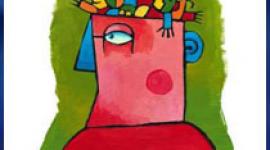Child Abuse And Multiple Personality Disorder
Department of Psychiatry, Indiana University School of Medicine
Abstract: The syndrome of multiple personality is associated with a high incidence of physical and/or sexual abuse in childhood. Occasionally those with multiple personality abuse their own children. Multiple personality is difficult to diagnose both because of the nature of the syndrome and because of professional reluctance. Although multiple personality is most difficult to diagnose during childhood because of the subtlety of the syndrome. The much higher morbidity found in adult cases makes it imperative that it be diagnosed and treated early in order to avoid further abuse and greater morbidity and to shorten treatment time. This review describes the history, clinical features and treatment of multiple personality, particularly in children, in addition to exploring the professional reluctance to make the diagnosis.
Introduction: MULTIPLE PERSONALITY DISORDER is of special interest to clinicians interested in child abuse and neglect because patients with multiple personality were almost invariably abused either physically or sexually when they were children. Like other victims of child abuse. sometimes those with multiple personality abuse their children. Also. like child abuse. there is a professional reluctance to diagnose multiple personality. Perhaps most importantly, clinicians working in the area of child abuse have the opportunity of diagnosing incipient multiple personality in children and initiate early intervention leading to successful treatment.
History Of Multiple Personality
The history of the dissociative disorders, which include multiple personality, extends back into the New Testament times of the first century when numerous references to demon possession, a forerunner of multiple personality, were described [1, 2]. The phenomenon of possession continued to be prevalent until well into the 19th century and is still prevalent in certain areas of the world [2, 3]. However, beginning in the 18th century, the possession phenomenon began to decline and the first case of multiple was described by Eberhardt Gmelin in 1791 [2]. The first American case, that of Mary Reynolds, was first reported in 1815 [2]. The late 19th century saw a flurry of publications about multiple personality [4], but the relationship of multiple personality to child abuse was not generally recognized until the publication of Sybil in 1973 [5]. The growth of interest in multiple personality has paralleled that of incest with which it is closely related. The reports of both incest and multiple personality have greatly increased since 1970 [6].
Clinical Description Of Multiple Personality
Multiple personality is defined by the DSM-III as:
- The existence within the individual of two or more distinct personalities. Each of which is dominant at a particular time.
- The personality that is dominant at any particular time determines the individual's behavior.
- Each individual personality is complex and integrated with its own unique behavior patterns and social relationships [7].
Unfortunately the description of multiple personality in the DSM-111 has led, in part, to frequent misdiagnosis and under diagnosis [8]. Multiple personality most often presents with depression and suicidality rather than personality changes and amnesia which are obvious clues to dissociation |3, 8]. The amnesia in multiple personality includes amnesia for traumatic experiences in the remote past and amnesia for recent events which occurred while the individual was dissociated into another personality. Often emotional stress precipitates dissociation. The amnesiac episodes generally last from a few minutes to a few hours but occasionally may last from a few days to a few months. The original personality is usually amnesiac for the secondary personalities while the secondary personalities may have varying awareness of one another. Sometimes a secondary personality may exhibit the phenomenon of co-consciousness and be aware of events even when another personality is dominant. Generally the original personality is rather reserved and depleted of affect [5]. The secondary personalities usually express affects or impulses unacceptable to the primary personality such as anger, depression, or sexuality. Differences between personalities may be quite subtle or quite striking. Personalities may be of different age, race, sex, sexual orientation, or parentage from the original. Most often the personalities have chosen proper names for themselves. Psychophysiologic symptoms are extremely frequent in multiple personality [9]. Headaches are extremely common as are hysterical conversion symptoms and symptoms of sexual dysfunction [3, 10].
Transient psychotic episodes may occur in multiple personality [11]. Hallucinations during such episodes are usually of a complex visual nature indicating an hysterical type of psychosis. Sometimes a personality will hear the voices of other personalities. These voices, which occasionally are of a command type, appear to come from inside the head, and should not be confused with the auditory hallucinations of the schizophrenic which usually come from outside the head. Most often stress precipitates the transition between personalities. These transitions may be dramatic or quite subtle. In a clinical situation the transition may be facilitated by asking to speak to a particular personality or by the use of hypnosis. The switching process usually takes several seconds while the patient closes the eyes or appears to look blank, as if in a trance.
The onset of multiple personality generally occurs in childhood, although the condition is not usually diagnosed until adolescence or early adulthood. The sex incidence is about 85% female [11]. This increased incidence of multiple personality in women may occur because sexual abuse and incest, which are strongly associated with multiple personality, occur predominantly in female children and adolescents. The degree of impairment in multiple personality may vary from mild to severe. Although multiple personality was thought to be quite rare, recently it has been reported to be more common [8].
Types Of Child Abuse Experienced By Multiple Personality Victims
Trauma has long been recognized as an essential criterion for the production of dissociative disorders including multiple personality [12]. The various types of trauma include childhood physical and sexual abuse. rape, combat, natural disasters, accidents, concentration camp experiences, loss of loved ones, financial catastrophes. and severe marital discord [12]. As early as 1896, Freud recognized that early childhood seduction experiences were responsible for 18 female cases of hysteria, a condition closely associated with dissociative disorders [13]. In the famous case of Dora. the patient's complaint of a sexually seductive adult was corroborated by other family members [14. 15]. In another famous case of hysteria, Anna O, who suffered from dual personality, the initial trauma was the death of Anna O's father [16. 17].
It was not until the publication of Sybil in 1973 that childhood physical and sexual abuse became widely recognized as precipitants of multiple personality [5]. Since 1973 numerous investigators have confirmed the high incidence of physical and sexual abuse in multiple personality [6, 18, 19]. In 100 cases Putnam found an 83% incidence of sexual abuse, 75% incidence of physical abuse, 61% incidence of extreme neglect or abandonment. and an overall 97% incidence of any type of trauma [20]. In Bliss' series of 70 patients, of whom only 32 met the DSM-111 criteria for multiple personality, there was a 40% incidence of physical abuse and a 60% incidence of sexual abuse in the female patients [21]. Coons reports a 75% incidence of sexual abuse. a 55% incidence of physical abuse, and an overall 85% incidence of either type of abuse in a series of 20 patients [10]. The types of child abuse experienced by victims of multiple personality are quite varied [22]. Sexual abuses include incest, rape, sexual molestation. sodomy. cutting of the sexual organs, and inserting objects into the sexual organs. Physical abuses include cutting, bruising. beating, hanging. tying up, and being locked in closets and cellars. Neglect and verbal abuse are also common.
The abuse in multiple personality is usually severe, prolonged. and perpetrated by family members who are bound to the child in a love-hate relationship [IO, 22, 23]. For example, in one study of 20 patients. abuse occurred over periods ranging from 1 to 16 years. In only one instance was the abuser not a family member. The abuses included incest. sexual molestation, beating, neglect, burning and verbal abuse.
Multiple Personality Disorder In Children
No cases of childhood multiple personality disorder were reported between 1840 and 1984 [24]. In 1840 Despine Pete reported the first case of childhood multiple personality in an Il-year-old girl [2]. Since 1984 at least seven cases of childhood multiple personality disorder have appeared in the literature [24-27]. The reported cases range in age from 8 to 12 years.
From these first few reported cases the symptoms characteristic of childhood multiple personality begin to emerge and reveal some marked differences when compared to adults [25]. In the childhood form of multiple personality the difference between personalities are quite subtle. In addition the number of personalities is fewer. So far an average of 4 (range 2-6) personalities have been reported in children. while the average number of personalities reported in adults is about 13 (range 2 to 100+). Symptoms of depression and somatic complaints are less common in children but the symptoms of amnesia and inner voices are not decreased. Perhaps most importantly, the therapy of children with multiple personality is usually brief and marked by steady improvement. In adults therapy may last anywhere from 2 to over 10 years. while in children therapy may only last a few months. Kluft believes this shorter therapy time is due to the lack of narcissistic investment in separateness [25].
Kluft and Putnam have derived a list of symptoms characteristic of childhood multiple personality disorder [24]. The main characteristics include the following:
- A history of repeated child abuse.
- Subtle alternating personality changes such as a shy child with depressed. angry. seductive. and/or regressive episodes.
- Amnesia of abuse and/or other recent events such as schoolwork. angry outbursts, regressive behavior. etc.
- Marked variations in abilities such as schoolwork. games. and music.
- Trance-like states.
- Hallucinated voices.
- Intermittent depression.
- Disavowed behaviors leading to being called a liar.
Childhood Abuse Perpetrated By Adults With Multiple Personality
Relatively little is known about multiple personality parents who abuse their children. In the only study to date. the children of parents with multiple personality disorder tend to have a higher rate of psychiatric disturbance when compared to a control group of children with parents having other psychiatric disturbances.. where. the incidence of child abuse between the two groups was not significant [28]:In this 'study child abuse occurred in 2 of 20 families which included at least one multiple personality parent. In one family the son of a multiple personality mother was severely neglected secondarily to the mother's frequent dissociation and the severe drug abuse by both parents. This child was subsequently removed from the home. In the second family the father. who was not a multiple personality. sexually abused his son. The abuse ceased when the parents divorced but began again when the father regained custody secondarily to the mother's inability to control her teenage son. Most of the multiple personality parents in this series tried to be very good parents in order to insure that their children did not suffer child abuse as they had.
In another reported case an 18-month-old girl was physically abused by her stepfather who was a multiple personality [29]. The abuse ceased when the parents divorced subsequent to the episode of physical abuse which left the child in a transient coma and a retinal hemorrhage.
The management of parents with multiple personality who abuse their children should be handled like any other case of child abuse. The child abuse should be reported to the appropriate child protective services and the child should be removed from the home if necessary. Obviously the parent with multiple personality should be in therapy and attempts to help the abusive personality should be of paramount importance. Management should then proceed on a case by case bases [30, 31].
Professional Reluctance To Diagnose Multiple Personality
Like child abuse, particularly incest, there is a professional reluctance to diagnose multiple personality disorder. In all likelihood this reluctance stems from a number of factors including the generally subtle presentation of the symptoms, the fearful reluctance of the patient to divulge important clinical information, professional ignorance concerning dissociative disorders, and the reluctance of the clinician to believe that incest actually occurs and is not the product of fantasy.
If the patient with multiple personality presents with depression and suicidality and if the differences between personalities is subtle, the diagnosis may be missed. The changes in personality may be attributed to a simple mood change. for instance. In other cases individuals with multiple personality may go through prolonged periods without dissociation, and, therefore, the diagnosis is missed because a "window of diagnosibility" did not exist at the time of the clinical examination [8].
In addition to the subtle presentation of multiple personality, most individuals with this disorder consciously withhold vital clinical information about memory loss, hallucinations, and knowledge of other personalities in order to avoid being labeled "crazy." Others withhold information out of distrust. Still others are totally unaware that they are symptomatic. For instance, they may be completely unaware of alter personalities, and the time loss or time distortion which they experience may have occurred for such a long time that they consider it to be normal.
Professional ignorance about multiple personality is likely to be due to several factors. Because multiple personality was thought to be a rare disorder, many clinicians assumed that they would never see one in their practice. This false assumption caused many clinicians not to consider multiple personality in their differential diagnosis. In addition multiple personality did not appear as an official disorder until the publication of DSM-111 in 1980. Finally. until the past ten years, many psychiatric journals refused to publish articles about multiple personality because the disorder was felt to be rare or nonexistent and of little interest to their readers.
The reluctance of the clinician to believe that incest occurred in their patients is perhaps the most troubling aspect regarding the misdiagnosis of multiple personality. In many cases stories of incest have been assumed to be fantasies or outright lies. This practice of nonbelief has occurred despite examples where sexual abuse has been carefully confirmed with collateral sources [5, 32]. A number of authors [33-35] have written about this problem of clinician disbelief which is thought to be a counter transference reaction to the traumatized victim [34].
Undoubtedly Freud's renunciation of his earlier belief in the seduction theory was a setback to understanding incest [36]. For many years after Freud's renunciation, clinicians assumed stories of incest to be fantasy. Benedek pointed out that the counter transference reactions to victim's traumatic abuse included extreme anxiety about the abuse and resultant avoidance of the topic, a conspiracy to maintain silence about the abuse, and blaming the victim for the abuse [34]. Goodwin suggested that the clinician's incredulity regarding the abuse functions to make one believe that the patient and her family are not as sick as they seem, and, therefore, the uncomfortable reality of having to report abuse or appear in court is unnecessary [35]. Goodwin also suggested that disbelief shields the clinician from the powerful rage expressed by the victim and her family if confrontation about the abuse occurs.
Treatment Of Multiple Personality Disorder
Since several excellent reviews of the treatment of multiple personality disorder exist [6, 37-40], treatment will only be summarized here. Particular emphasis will be placed on treatment of multiple personality in children. In the initial phase of treatment, trust is an extremely important issue. Trust may be very difficult to obtain because of the previous childhood maltreatment. Trust may also be difficult to obtain because of previous misdiagnosis and disbelief. Once the patient feels understood and believed, however, the patient becomes a steadfast and willing partner in the treatment process.
In adults the making of the diagnosis and the sharing of the diagnosis with the patient is an important part of the initial therapy. This sharing process must be done in a gentle and timely manner to avoid the patient fleeing therapy after becoming fearful of the implications of dissociation. This particular step in therapy with children is relatively unimportant because of their relative lack of abstractive ability and the lack of narcissistic investment in separateness by the alter personalities.
A third task in the initial phase of treatment is to establish communication with all of the alter personalities in order to learn their names, origins, functions, problems, and relationships to the other personalities. In case any of the personalities are dangerous to themselves or others, contracts should be made against acting out in any harmful manner.
The initial phase of therapy may occur very rapidly or may take several months depending on the amount of trust present. The middle phase of treatment is the most lengthy phase and may extend into years of work.
The middle phase of treatment involves helping the original personality and the alter personalities with their problems. The original personality needs to learn how to cope with dissociated affects and impulses such as anger, depression, and sexuality. The traumatic experiences should be explored and worked through with all of the personalities. The therapeutic use of dreams, fantasies, and hallucinations can be very helpful in this working through process. Amnesiac barriers should be broken down during this middle phase. This may be accomplished through the use of audio tapes, videotapes, journal writing, hypnosis, and direct feedback from the therapist or significant relations. Intrapersonality cooperation and communication should be facilitated during this phase of treatment.
The final phase of therapy involves fusion or integration of the personalities. Although hypnosis may facilitate this process, it is not absolutely necessary. Therapy does not end with integration, however, as integrated patients must practice their newfound intrapsychic defenses and coping mechanisms or the risk of renewed dissociation is great. The patient's transference, especially the dependence, hostility, or seductiveness towards the therapist, may sorely test the therapist's patience. Likewise the therapist's counter transference feelings, which may include over fascination, over investment, intellectualization, withdrawal, disbelief, bewilderment, exasperation, anger, or exhaustion, should be closely monitored. Hospital treatment may be useful to protect the patient from self-destructive urges, treat psychotic episodes, or to treat a severely dysfunctional patient who is unable to provide for basic needs. Psychotropic medication does not treat the basic psychopathology of multiple personality. Antipsychotic medication may be useful temporarily to treat a brief psychosis. Antidepressants are occasionally useful for an accompanying affective disorder. Minor tranquilizers should be avoided except for temporary use to decrease massive anxiety because of the significant abuse potential in multiple personality. Alcohol and drugs are frequently used and abused by the patient to avoid painful affects and memories. The treatment of a child with multiple personality takes far less time than treatment of an adult. In the treatment of children Kluft and Fagan and McMahon utilized various techniques including play therapy, hypnotherapy, and abreaction in order to bring about integration [25, 26]. Kluft placed particular emphasis on family intervention and agency involvement both to prevent further abuse and to alter pathological patterns of interaction.
Conclusions
The psychiatric syndrome of multiple personality is associated with an extremely high incidence of physical and/or sexual abuse during childhood. The abuse is usually severe, prolonged, and perpetrated by family members. Multiple personality may be difficult to diagnose because of the subtlety of the presenting symptoms. the patient's fear of being labeled crazy and the clinician's mistaken belief that multiple personality is a rare condition. Currently multiple personality is usually diagnosed in adults who are in their late 20s or early 30s. The diagnosis of multiple personality in children is even more difficult because of the subtlety of symptoms and the ease with which these symptoms are confused with fantasy. Although individuals with multiple personality do not usually abuse their own children, the incidence of psychiatric disturbance in their children is high. Multiple personality is much easier to treat if diagnosed early in childhood or adolescence. Therefore, in order to decrease the morbidity of multiple personality and decrease the psychiatric disturbance in children of multiple personality parents, it behooves the clinician to become well acquainted with the syndrome of multiple personality, to diagnose multiple personality as early as possible, and to insure that the individual with multiple personality obtains effective treatment.
next:Multiple Personality Mirrors of a New Model of Mind?
REFERENCES
1. OESTERREICH, T.C. Possession and Exorcism. Causeway Books. New York (1974).
2. ELLENBERGER. H. E The Discovery of the Unconscious. Basic Books. New York
3. COONS. P.M. The differential diagnosis of multiple personality: A comprehensive review. Psychiatric' Clinics of North America 7:51-67 (1984).
4. TAYLOR, W.S. and MARTIN. M. E Multiple personality. Journal of Abnormal and Social Psychology 39:281-300 ( 1944].
5. SCHREIBER. E R. Sybil. Regnery. Chicago (1973).
6. GREAVES, G.B. Multiple personality 165 years after Mary Reynolds. Journal of Nervous and Mental Disease 168:577-596 (1980).
7. AMERICAN PSYCHIATRIC ASSOCIATION. Diagnostic' and Statistical Manual of Mental Disorders, (3rd ed.). Amencan Psychiatric Association. Washington. DC (1980).
8. KLUFT. R.P. Making the diagnosis of multiple personality (MPD). Directions in Psychiatr*.' 5:1-11 (1985).
9. BLISS, E.C. Multiple personalities: A report of 14 cases with implications for schizophrenia. Archives of General Psychiatry 257:1388-1397 (1980).
10. COONS. P.M. Psychosexual disturbances in multiple personality: Characteristics. etiology. and treatment. Journal of Clinical Psychiatry. (In press). 1. COONS. P.M. Multiple personality: Diagnostic considerations. Journal of Clinical Psychiatry.' 41: 1980).
11. COONS.P.M. Multiple personality: Diagnostic consideration. Journal of Clinical Psychiatry 41:330-336 (1980).
12. PUTNAM. F W. Dissociation as a response to extreme trauma. In: Childhood Antecedents of Multiple Personality, R.P. Kluft (Ed.). pp. 65-97. American Psychiatric Association. Washington. DC (1985).
13. FREUD. S. The etiology of hysteria. In: The Standard Edition of the Complete Psychological Works. (Vol.3). T. Strachey (Ed.). Hogarth Press. London (1962).
14. FREUD. S. Dora: An Analysis of a Case of Hysteria. C. Rieff(Ed.). Collier Books. New York (1983).
15. GOODWIN. J. Post-traumatic symptoms in incest victims. In: Post-Trattmatic Stress Disorder in Children. S. Eth and R.S. Pynoos (Eds.). pp. 157-168. American Psychiatric Association. Washington. DC (1985).
16. BREUER. J. and FREUD. S. Slitdies in Hysteria. J. Strachey [Ed.). Basic Books. New York (1983).
17. JONES. E. The Life and Work of.Sigmund Freud. (Vol. 1). New York. Basic Books 11953).
18 .BOOR. M. The multiple personality epidemic: Additional cases and inferences regarding diagnosis. etiology and treatment. Journal of Nervous and Mental Disease 170:302-304 [1982).
19. SALTMAN, V. and SOLOMON. R.S. Incest and multiple personality. Psychological Reports 50:1127-1141 (1982).
20. PUTNAM. E W.. POST. R.M., GUROFF. J., SILBERMAN. M.D. and BARBAN. L. IOO cases of multiPleDC (1983).Personality disorder. New Research Abstract #77. American Psychiatric Association. Washington.
21. BLISS. E.L. A symptom profile of patients with multiple personalities including MMPI results. Journal of Nervous and Mental Disease 172:197-202 (1984).
22. WILBUR. C.B. Multiple personality and child abuse. Psychiatric Clinics of North America 7:3-8
APA Reference
Staff, H.
(2008, December 5). Child Abuse And Multiple Personality Disorder, HealthyPlace. Retrieved
on 2025, July 18 from https://www.healthyplace.com/abuse/wermany/child-abuse-and-multiple-personality-disorder



